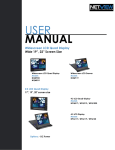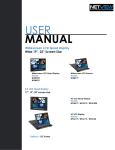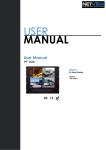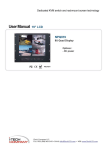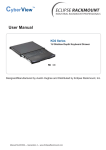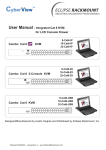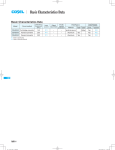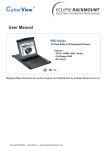Download USER MANUAL - I
Transcript
USER MANUAL Rackmount Quad Display Panel NPQ919 9U 19” NPQ1020 10U 20” Options: -DC power i-Tech Company LLC TOLL FREE: (888) 483-2418 email: [email protected] web: www.iTechLCD.com User Manual Legal Information First English printing, October 2002 Information in this document has been carefully checked for accuracy; however, no guarantee is given to the correctness of the contents. The information in this document is subject to change without notice. We are not liable for any injury or loss that results from the use of this equipment. Safety Instructions Please read all of these instructions carefully before you use the device. Save this manual for future reference. ■ ■ ■ ■ ■ ■ ■ ■ ■ ■ Unplug equipment before cleaning. Don’t use liquid or spray detergent; use a moist cloth. Keep equipment away from excessive humidity and heat. Preferably, keep it in an air-conditioned environment with temperatures not exceeding 40º Celsius (104º Fahrenheit). When installing, place the equipment on a sturdy, level surface to prevent it from accidentally falling and causing dam age to other equipment or injury to persons nearby. When the equipment is in an open position, do not cover, block or in any way obstruct the gap between it and the power supply. Proper air convection is necessary to keep it from overheating. Arrange the equipment’s power cord in such a way that others won’t trip or fall over it. If you are using a power cord that didn’t ship with the equipment, ensure that it is rated for the voltage and current labeled on the equipment’s electrical ratings label. The voltage rating on the cord should be higher than the one listed on the equipment’s ratings label. Observe all precautions and warnings attached to the equipment. If you don’t intend on using the equipment for a long time, disconnect it from the power outlet to prevent being dam aged by transient over-voltage. Keep all liquids away from the equipment to minimize the risk of accidental spillage. Liquid spilled on to the power supply or on other hardware may cause damage, fi re or electrical shock. Only qualifi ed service personnel should open the chassis. Opening it yourself could damage the equipment and invali date its warranty. ■ If any part of the equipment becomes damaged or stops functioning, have it checked by qualifi ed service personnel. What the warranty does not cover ■ ■ ■ Any product, on which the serial number has been defaced, modifi ed or removed. Damage, deterioration or malfunction resulting from: □ Accident, misuse, neglect, fi re, water, lightning, or other acts of nature, unauthorized product modifi cation, or failure to follow instructions supplied with the product. □ Repair or attempted repair by anyone not authorized by us. □ Any damage of the product due to shipment. □ Removal or installation of the product. □ Causes external to the product, such as electric power fl uctuation or failure. □ Use of supplies or parts not meeting our specifications. □ Normal wear and tear. □ Any other causes which does not relate to a product defect. Removal, installation, and set-up service charges. Regulatory Notices Federal Communications Commission (FCC) This equipment has been tested and found to comply with the limits for a Class B digital device, pursuant to Part 15 of the FCC rules. These limits are designed to provide reasonable protection against harmful interference in a residential installation. Any changes or modifi cations made to this equipment may void the user’s authority to operate this equipment. This equipment generates, uses, and can radiate radio frequency energy and, if not installed and used in accordance with the instructions, may cause harmful interference to radio communications. However, there is no guarantee that interference will not occur in a particular installation. If this equipment does cause harmful interference to radio or television reception, which can be determined by turning the equipment off and on, the user is encouraged to try to correct the interference by one or more of the following measures: ■ Re-position or relocate the receiving antenna. ■ Increase the separation between the equipment and receiver. ■ Connect the equipment into an outlet on a circuit different from that to which the receiver is connected. User Manual Contents < Part 1 > NPQ919 1.1 1.2 1.3 1.4 1.5 1.6 NPQ1020 Package Contents Structure Diagram & Dimension Installation LCD On-screen Display Operation LCD Specifi cation Option : DC Power P. 1 P. 2 P. 3 P. 4 P.5 P.6 < Part 2 > Quad Display Connection & Operation 2.1 2.2 2.3 2.4 2.5 2.6 2.7 QD Connection QD ALARM Connection & Operation QD Remote Control Connection & Operation QD OSD Operation QD On-screen Menu QD VCR Operation QD Specifi cation P.7 P.8 - 9 P.10 - 14 P.15 P.16 - 18 P.19 P.20 User Manual Before Installation ■ It is very important to mount the equipment in a suitable cabinet or on a stable surface. ■ Make sure the place has a good ventilation, is out of direct sunlight, away from sources of excessive dust, dirt, heat, water, moisture and vibration. Unpacking The equipment comes with the standard parts shown in package content. Check and make sure they are included and in good condition. If anything is missing, or damaged, contact the supplier immediately. < Part 1 > NPQ919 / 1020 < 1.1 > Package Content P.1 User Manual < 1.2 > Structure Diagram & Dimension Model Product Dimension (W x D x H) NPQ919 / 1020 Packing Dimension (W x D x H) Net Weight Gross Weight NPQ919 480 x 68.5 mm 18.9 x 2.7” 9U 583 x 529 x 124 mm 23 x 20.8 x 4.9" 8 kg 18 lb 10 kg 22 lb NPQ1020 480 x 71.5 mm 18.9 x 2.8” 10U 583 x 529 x 164 mm 23 x 20.8 x 6.5" 9 kg 20 lb 12.5 kg 28 lb P. 2 User Manual < 1.3 > Installation Step 1 ■ Mount the display panel with M6 screw set. M6 screw sets are not provided. Step 22 ■ Fix the display panel into the rack. P. 3 User Manual < 1.4 > On-screen Display Operation ( OSD ) P. 4 NPQ919 / 1020 User Manual < 1.5 > LCD Specifi cation Item LCD Manufacturer Diagonal Size Max. Resolution Brightness (cd/m²) Color Support Description Samsung LG 19" TFT 20" TFT 1280 x 1024 1600 x 1200 250 300 16.7 M 16.7 M Contrast Ratio (typ.) 1000:1 800:1 Viewing Angle (H/V) 160° x 160° 178° x 178° 376 x 301 408 x 306 Active Area (mm) Response Time Tr + Tf (ms) LCD Panel MTBF (hrs) 5 16 50,000 45,000 Analog RGB, 0.7Vp-p VGA Signal Input Sync. Type Separate H/V, Composite, SOG Resolution 800 x 600, 60/ 70/ 72/ 75 Hz 1024 x 768, 60/ 70/ 75 Hz 1152 x 864, 60/ 70/ 75 Hz 1280 x 720, 60/ 75 Hz 1280 x 1024, 60/ 70/ 75 Hz - 1400 x 1050, 60 Hz DB-15 connector Connector Power Input Auto-sensing 100 to 240VAC, 50 / 60Hz Max. 48 Watt, Standby 5 Watt Power Consumption Compatibility 1600 x 1200, 60 Hz EDID 1.3 Plug & Play DDC Multi-platform - Mix PCs, SUNs, IBMs, HPs & DELLs. FCC, CE Regulation Approval Environmental 0° to 50°C Degree Operation -5° to 60 °C Degree Storage 5~90%, non-condensing Relative Humidity 10G acceleration (11ms duration) Shock Vibration 5~500Hz 1G RMS random vibration P. 5 User Manual < 1.6 > Option : DC power NPQ919 / 1020 DC Power Option Model 12V 24V 48V Input voltage: 12-Volt 24-Volt 48-Volt Input range: 9 ~ 18V 18 ~ 36V 36 ~ 75V - No load 50 mA 50 mA 50 mA - Full load 4950 mA 2450 mA 1220 mA Output voltage: 12-Volt 12-Volt 12-Volt Output current: 4.16A 4.16A 4.16A 84% 85% 85% Input rating Input current Output rating Effi ciency P. 6 User Manual < Part 2 > < 2.1 > QD Connection 1. VCR in : This BNC connector is connected to video output from VCR/DVR. A pre-recorded quad screen signal from a tape can be played back through a VCR/DVR and displayed on the video output channels. Push the VCR button (#2) to switch the device to VCR Playback mode. 2. VCR out : This BNC connector is to be connected to the Video in from your VCR/DVR. It will only provide a quad screen video to ensure an un-interrupted video recording for all four cameras. The display video is not affected by the control panel. 3. Terminations : These impedance switches are used to provide proper termination for each camera input. These switches toggle between 75Q and Hi-Z impedance. Incorrect termination will degrade the quality of the video signal. All video inputs not “looped through” to another device, the corresponding switches need to be set to 75Q termination position. If another device is connected to video out loop through connector set the corresponding termination switch to Hi-Z position. Any device connected to the video out loop through connectors needs to be confi gure to 75Q video termination. The factory default termination setting is 75Q. 4. Ch1 In, Ch2 In, Ch3 In, and Ch4 In Video IN connectors : These BNC connectors are used to connect to the video out from camera. Four cameras can be connected to these connectors to form a quad screen in the following mapping order. 1 2 3 4 5. Ch1 Out, Ch2 Out, Ch3 Out, and Ch4 Out Video Loop through connectors : These connectors are used to loop video signals from each camera out to other devices. P. 7 User Manual < 2.2 > QD ALARM Connection & Operation NPQ919 / 1020 1. ALARM I/O : This female type 9 pin D-sub connector is used for alarm sensor input and alarm output control connections. It provides Normal Open and Normal Close contacts for alarm out control. The Alarm Hold Time can be confi gured from 0 second to 99 minutes through system Setup menu. 2. VCR Connection for Tape Recording Start and Stop Control : Connecting the contacts of VCR RECORD and STOP switch to the alarm output NC and NO contacts will allow you to use an ordinary VCR to record for longer period of time. Combined with alarm sensor detection, the VCR will record only when an alarm sensor is activated. *. If more than one sensor have been trigged, VCR will start to record after the last trigged event. *. In order to make use of the alarm called full screen display function, the VIDEO IN connector from the VCR has to be connected to LIVE monitor connector of the device. If more than one sensor are trigged, VCR will then record all the events in full screen mode accordingly. P. 8 User Manual < 2.2 > QD ALARM Connection & Operation 3 Sensor Activated Alarm The unit is equipped with 4 alarm sensor inputs. If any alarm is activated: ■ ■ ■ the built-in buzzer and the alarm output control relay contact will be activated. the quad will switch the corresponding channel indicator LED to blinking mode. a warning message depending on different models will be displayed as follows: Above mentioned alarm can be cleared by any of the following: 1. Connecting the Alarm Reset In contact, pin #5, of the female type 9 pin D-sub connector (#8) to GND. 2. The Alarm Duration time elapses. 3. If the device is operated under Security Lock ON mode, Push Lock button for 2 seconds to disable the function then push any button in the front panel. 4 Video Loss Alarm Loss of video at any input is automatically detected by the device. The device will: ■ ■ ■ Activate the built-in buzzer. Switch the corresponding channel indicator LED to blinking mode. Display warning message on quad screen: ■ The warning message and the buzzer can be cleared by pushing Lock button (#2) for more than 4 seconds if the device is operated under Security lock On mode, or pushing any button on the front panel if the device is operated under Security lock OFF mode. P. 9 User Manual < 2.3 > QD Remote Control Connection & Operation P.10 NPQ919 / 1020 User Manual < 2.3 > QD Remote Control Connection & Operation The device can be controlled via the male type 9 pin D-sub/RS-232 connector to a computer using ASCII code. 1. Pin assignment of the male type 9 pin D-sub connector: When a computer is used to control this device through a RS-232 port, pin 6, 7, 8, and 9 must be disconnected to prevent connecting the VCC and GND signals from the device to the computer. A RS-232 port only uses pin 1, 2, and 3 for control signal transmission. 2. A terminal or computer can be connected to the male type 9 pin D-sub connector on the real panel from it RS-232 port to control this device using standard, uppercase ASCII codes. 2.1 The ASCII command codes for the quad are listed in the table below. The transmission protocol is 1200-baud rate, 8 data bit, 1 start bit, 1 stop bit, and no parity. Function ASCII Command Code Quad Screen Display E CH 1 A CH 2 B CH 3 C CH 4 D Freeze *1 EA, EB, EC, ED Auto Switching Sequence F VCR/Live G Key Lock *2 H Setup Menu *3 GH Text Select Down *4 (GH) A Text Select Up (GH) B Cursor Left (GH) C Cursor Right (GH) D Alarm Reset I P.11 User Manual < 2.3 > QD Remote Control Connection & Operation NPQ919 / 1020 *1. In order to control the device to operate in Zoom mode, the computer has to fi rst send command code ” to switch the signal source from camera to VCR/DVR, at this time the device will automatically zoom channel 1 video from VCR/DVR to full screen. User can then input a corresponding channel code to zoom any other specifi c channel. Input the corresponding channel code again to put the specifi c channel to freeze mode and send the code again to clear the freeze mode. Example: Input GE, (GE) B, (GE) C, and (GE) D for zooming the video signal in channel 1 to 4 from VCR/DVR. Input “A”, “B”, “C”, “D” again to freeze the specifi c channel. Send command code “G” again to get back to Live input mode. *2. Computer has to send out command code “H” continuously for 2 seconds to switch the device between security lock ON and OFF mode. If any alarm is activated under security lock ON mode, the device has to send out command code “H” continuously for more than 4 seconds to clear the alarm. *3. Setup menu is switched ON by sending VCR/DVR and Lock button codes together. *4. Text Select and Cursor Control functions can be performed only under menu Setup mode. 2.2 Right after computer/terminal has sent out the above mentioned control command code to the device, the device will respond with following status code back to computer through RS-232 port: Status Code Quad Status Status Code Quad Status EF Device in Quad mode DE CH1 in Sequence mode EE CH1 in Freeze mode DD CH2 in Sequence mode ED CH2 in Freeze mode DB CH3 in Sequence mode EC CH1 & 2 in Freeze mode D7 CH4 in Sequence mode EB CH3 in Freeze mode CF Quad display in Sequence mode EA CH1 & 3 in Freeze mode E9 CH2 & 3 in Freeze mode E CH1 in Full screen mode E8 CH1, 2, & 3 in Freeze mode D CH2 in Full screen mode E7 CH4 in Freeze mode B CH3 in Full screen mode E6 CH1 & 4 in Freeze mode 7 CH4 in Full screen mode E5 CH2 & 4 in Freeze mode E4 CH1, 2 & 4 in Freeze mode E3 CH3 & 4 in Freeze mode E2 CH1, 3, & 4 in Freeze mode XX-7F Security lock ON E1 CH2, 3, & 4 in Freeze mode XX-3F Buzzer & Security lock ON (Stop) E0 CH1, 2,3, & 4 in Freeze mode Attach to above code XX-DF P.12 Buzzer/VCR ON User Manual < 2.3 > QD Remote Control Connection & Operation 2.3 The confi guration of the status code for both normal and alarm operations: There are total 2 bytes of the status codes. Byte one, the fi rst 8 bits, shows the current status of the operation modes that the unit is in. Byte two, the second 8 bits, shows the current status of the alarm operations of the unit. BYTE 1: Status code for normal operation modes P.13 User Manual < 2.3 > QD Remote Control Connection & Operation NPQ919 / 1020 BYTE 2: Status code for alarm operations: The fi rst 4 bits show the sensor activated alarm status of each channel; next 4 bits show the video loss alarm status of each channel. The digit “1” means alarm event is detected, and “0” means no alarm event is detected. P.14 User Manual < 2.4 > QD OSD Operation 1 Lock: Security locks out button. Push this button for 2 seconds to enable control panel lock out function. Push this button again for 2 seconds to disable the function. 2 VCR: Push this button to enter into VCR Playback/Zoom operation. In this mode, the output video is displaying the video signal from VCR. When operated in Full Screen display mode, push select buttons (#5) to zoom any specifi c camera signal pre-recorded on the tape in quad format. Push the select button (#5) again to freeze the expanded picture on the screen. #1, #2 Setup buttons: Push these two buttons simultaneously to get into Menu Setup mode and display page 1 of system setup menu. Push these two buttons simultaneously again to display page 2 of the setup menu. Use page 1 to program time/date and camera title and page 2 to confi gure alarm operations. Under menu setup mode, Channel Select buttons (#5) are used for cursor control and text selection to program the setup menu. Push the setup buttons simultaneously again to save the setting. Push the setup buttons fourth time to get back to ordinary operation mode. Setup buttons (#1, #2) Function CH Select buttons (#5) UP, DOWN Push once Push twice 3 4 5 Page 1 menu for time / date / title programming Page 2 menu for alarm confi guration Push the third time Save the settings Push the fourth time Exit setup mode, back to normal < , > Text Selection Cursor Control Text Selection Cursor Control Yes / No SEQ.: Push this button to enable full page auto sequencing mode. Push this button again to disable it. Push this button to switch between Quad/ Full Screen display mode. buttons: When operated in Quad mode, these buttons are used to freeze any specifi c camera by pushing the corresponding button. When operated in Full Screen display mode, these buttons are used to select specifi c camera to be displayed in full screen. Quad button (#4) Channel Select buttons (#5) Function ON ON Freeze specifi c camera video in Quad screen mode OFF ON Call up specifi c camera video in full screen mode These buttons are also used as cursor control and text select keys under Setup menu mode. P.15 User Manual < 2.5 > QD On-screen Menu NPQ919 / 1020 Right after the unit is turned on, The monitor will display the last setting on the Setup Menu. 1. Page 1 of the Setup Menu - Display Setting Push Setup buttons (#1, #2) simultaneously to display the Setup Menu on the screen. There are total two pages in the Setup Menu. Page 1 is used to program TIME, DATE, and camera TITLE. Page 2 is used to program Alarm Operations. Under this mode, channel selection buttons (#5) on the front panel are used for cursor control and text selection. Use the cursor control buttons "<" and ">" to move the cursor to the location as desired to program, and use the text select buttons " ^" and "^" to choose the right alphanumeric character to program. Page 1: Setting the TIME, DATE, TITLE, and DWELL time: CH TITLE QUAD 1 CH 1 2 CH 2 3 CH 3 4 CH 4 LIVE VIDEO FREEZE VIDEO OUT: TITLE: TIME: 23 : 10 : 10 DATE: 12 - 25 - 2003 DWELL LIVE ON ON ON TIME 03S 03 S 03 S 03 S 03 S ON QUAD ON ON ON 1.1 TITLE setup: The Title menu permits the setup of separate titles for each video channel. 8 characters may be entered for each video channel. The available alphanumeric characters are: 1.2 DWELL Time setup: The Dwell time menu permits setting the dwell time for all cameras and the Quad Screen on the LIVE output channel. The menu shows a table of all cameras and associated dwell time. Dwell time can be programmed by setting a number between 00 to 99 for each channel in the menu. ■ 01 through 99: Adds the camera input to the auto switching SEQUENCE, with the corresponding dwell time in seconds. ■ 00: Skips the camera input in the auto switching SEQUENCE. 1.3 TIME/DATE setup: Time and date information can be displayed on the video output channel through both LIVE and QUAD connector. Bottom of page 1 is used to set the values of time and date and also to enable or disable the display at each output channel. The date and time will display in the “MM-DD-YYYY HH:MM:SS” format for NTSC model and “DD-MM-YYYY HH:MM:SS” format for PAL model. 1.4 TITLE/TIME/DATE disable and enable on LIVE and QUAD video output channel: The Title/Time/Date display on each output channel can be enabled or disabled by setting ON or OFF in the corresponding entry. P.16 User Manual < 2.5 > QD On-screen Menu 2 Page 2 of the setup menu- Alarm Setting Push Setup buttons (#1, #2) simultaneously and push (#1) button again to display page 2 of the setup menu on the screen. This Alarm Setting menu is used to set the desired alarm confi guration like sensor type, sensor sensitivity, alarm hold duration, and buzzer. ALARM SETTING CH SENSOR 1 OPEN 2 OPEN 3 OPEN 4 OPEN SENSITIVITY: DURATION: BUZZER: V-LOSS ALARM: V-LOSS RELAY: TYPE NO NO NO NO STATUS ON ON ON ON 0.3 S 30 S ON ON OFF 2.1 Sensor Type: The machine will fi rst detect the type of the sensor connected to the corresponding channel. The result will be displayed in the fi rst column following each channel number. They can be on either OPEN or CLOSE. The menu then allows user to enter a desired type of the sensor for each channel in next column. NO means Normally Open. NC means Normally Close. Then the menu will allow user to enable or disable sensor input for each channel in the next column. ON will enable the contact to detect the alarm status from the input. OFF will ignore the sensor input and disable the alarm detection from the input. Last column on this part of the menu shows the result of the actually detected sensor type and the desired confi guration. If the setup type of the sensor is different from the actually connected type of sensor, a blinking “?” message will display. In this case, the buzzer will be activated when you exit the setup operation. 2.2 Alarm Sensitivity: Alarm sensitivity can be programmed to different extent by setting the period of the trigged pulse detected by the sensor. The available settings are 100ms, 200ms, 300ms, 400ms, 500ms, 600ms, 700ms, and 800ms. 2.3 Alarm Hold Duration: The alarm hold duration can be set from 00 second to 59 minutes. The duration can be set to non-stop by choosing “>>“. In this mode, the activated alarm can only be reset by connecting the alarm reset contact to ground. 2.4 Buzzer: The device has a build-in buzzer to signal a detected alarm through sound. User can choose to disable the buzzer by setting it to OFF. 2.5 V-Loss Alarm: This entry is used to enable or disable the video loss alarm. The device automatically detects loss of video at any input if this entry is set to ON. User can choose to disable this feature by setting it to OFF for applications like video conferencing or others that will need constant video source switching. 2.6 V-Loss Relay Control: The device is equipped with an alarm controlled relay, which can be activated by both sensor trigged alarm and video loss alarm. This entry allows user to disable the relay activation from a loss of video in any camera input. 3 Save the settings and exit Setup Menu mode Push (#1) button again will allow you to save the settings and go back to the normal operation mode and show a quad display on the screen. P.17 User Manual < 2.5 > QD On-screen Menu NPQ919 / 1020 4: The setup menu can be reset to factory setting by pushing the Setup buttons (#1, #2) and power on the quad simultaneously. The factory setting is as follows: CH TITLE QUAD 1 CH 1 2 CH 2 3 CH 3 4 CH 4 LIVE VIDEO FREEZE VIDEO OUT: TITLE: TIME: 23 : 10 : 10 DATE: 12 - 25 - 2003 DWELL LIVE ON ON ON TIME 03S 03 S 03 S 03 S 03 S ON QUAD ON ON ON ALARM SETTING CH 1 NO 2 NO 3 NO 4 NO SENSITIVITY: SENSOR TYPE OPEN OPEN OPEN OPEN DURATION: BUZZER: V-LOSS ALARM: V-LOSS RELAY: STATUS ON ON ON ON 0.3 S 30 S ON ON OFF 5. The Quad Display Mode 5.1 Push Quad display button (#4) to switch between Quad screen and Full screen display mode. Right after you turn on the system, the unit is in the quad mode and displays cameras 1-4. 5.2 Use page 1 of the Setup menu to turn the Title display ON/OFF on each channel and also enable and disable the Time and Date display on LIVE and QUAD output channels. 5.3 Under Quad screen mode, push channel select button to freeze each camera input. 6. The Full Screen Display Mode 6.1 Push Quad button (#4) to OFF to enter Full screen display mode. Under this mode, you may call up any spe cifi c channel in full screen by simply pushing the corresponding channel selection button. 6.2 Push the Quad button (#4) to ON to return to the quad mode. 7. The Still Frame Display Mode 7.1 If the still screen mode is desired, fi rst turn the quad display button (#4) to ON to set the unit to display in the quad mode. At this time you may press any of the four channel selection buttons (#5) to freeze the corresponding channel. 7.2 Under Zoom On VCR playback mode, if the unit is showing quad screen, pushing the channel selection but tons (#5) will call up the specifi c channel to display in full screen. Push the same channel selection button again to freeze that channel in full screen. 8. The Auto-Sequence Mode Push the Sequence button (#3) to ON to set the device to work as a sequencer. Under this mode, the display sequence fi rst starts with a quad screen and then continues to display each camera input in full screen, and then gets back to quad screen and so on. Press the Sequence button (#3) to OFF to release this mode. P.18 User Manual < 2.6 > QD VCR Operation Zoom on VCR playback operation: Push VCR button (#2) to ON will switch the device to VCR playback mode. Under this mode, if the device is on quad display mode, a pr-recorded quad display video in the tape will be shown on the screen. If the device is in Full screen display mode, push any channel select buttons (#5) will select and expand the corresponding quadrants of the prerecorded video to full screen display. P.19 User Manual < 2.7 > Quad Display Specification NPQ919 / 1020 QD Specification P.20 User Manual The company reserves the right to modify product specifications without prior notice and assumes no responsibility for any error which may appear in this publication. All brand names, logo and registered trademarks are properties of their respective owners. Copyright 2011 i-Tech Company LLC. All rights reserved.

























